Climate change and its impact on our environment has become a critical concern for nations around the world – so much so that the United Nations proclaimed 2008 the ‘International Year of Planet Earth’. The initiative aims to raise awareness of the contribution of ‘earth sciences’ to our society – and to help future generations live in a safer and more prosperous world.
Issue information
New Zealand Post is committed to sustainability and currently exploring ways to minimise its impact on the environment. This stamp issue was part of that commitment – highlighting New Zealand’s own weather extremes, which are remarkably diverse for such a small nation. Each of the stamps in this issue focused on different elements of New Zealand's weather extremes.
Cold, Wet, Hot, Dry and Windy
As the climate warms, New Zealand is expected to experience more weather extremes. They will reach into all aspects of life in this country. The first day cover highlighted our weather extremes in one place, displaying all six stamps and their dramatic images illustrating the impact of climate change, which through warmer weather is expected to have a significant effect on our agricultural industry.
Insights into Climate Change from an Expert
Produced in strictly limited numbers (only 2,000) the limited edition was highly sought after by collectors worldwide. This individually numbered and authenticated limited edition included a number of unique features: a numbered miniature sheet and a special first day cover signed by Vince Neall, Chair of the New Zealand National Committee for the International Year of Planet Earth.
It also included indepth commentary on climate change and its impacts for us all from Erick Brenstrum, a severe weather forecaster with the MetService (New Zealand's National Meteorological Service) and author of The New Zealand Weather Book.
Product Listing for Weather Extremes
| Image | Title | Description | Price |
|---|---|---|---|
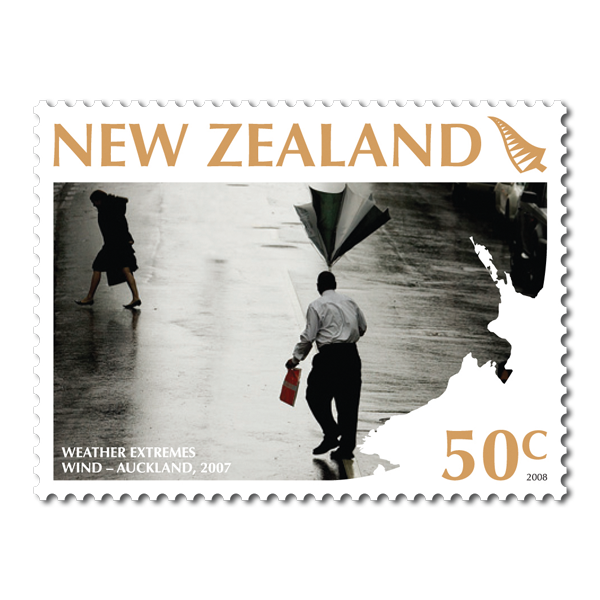 |
Single Stamp |
Single 50c 'Drought' gummed stamp. Drought can have a devastating impact on New Zealand’s economic wellbeing through its effects on our agricultural industry and the costs of lost agricultural production. Our prevailing westerly winds mean that most droughts happen in areas to the east of the main mountain ranges, with the dry air sucking the moisture out of vegetation and soil alike. |
$0.50 |
 |
Single Stamp |
Single 50c ' Wind' gummed stamp. The mountain ranges extending the length of New Zealand provide a barrier for the westerly winds, dividing the country into dramatically different climatic regions. In some places the wind is strong enough to be harnessed to provide energy; the two largest wind farms in the Southern Hemisphere are located in the North Island’s Tararua Ranges. |
$0.50 |
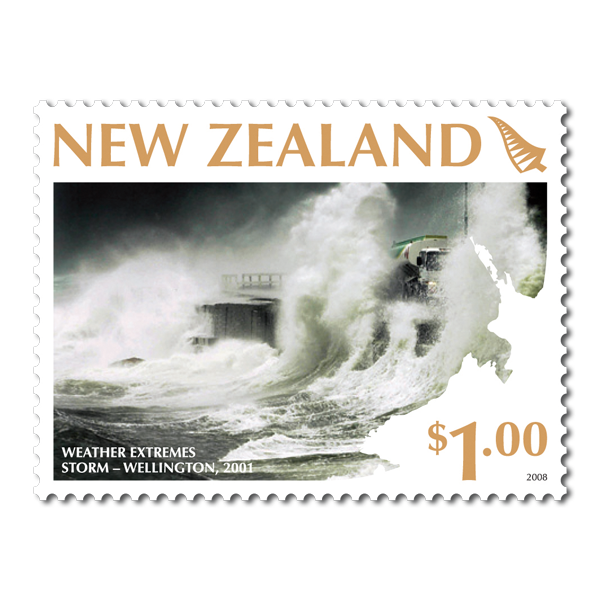 |
Single Stamp |
Single $1.00 'Storm' gummed stamp. The worst storms to affect New Zealand develop from the remains of tropical cyclones, which can re-intensify if they meet a strong cold front. Famous examples include 1988’s Cyclone Bola, which flooded Gisborne, 1968’s Cyclone Giselle, which sank the inter-island ferry the Wahine, and a 1936 storm that caused extensive flooding and wind damage, with buildings collapsing, trains blown off their tracks and bridges washed away. |
$1.00 |
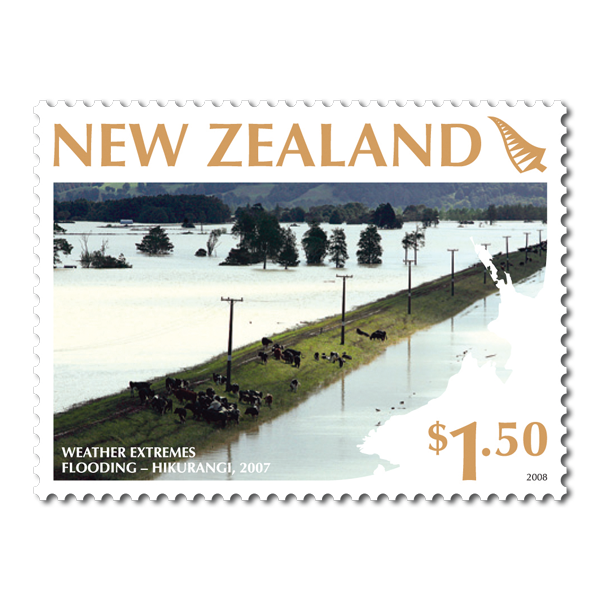 |
Single Stamp |
Single $1.50 'Flooding' gummed stamp. Most areas of New Zealand have between 600 and 1,600 millimetres of rainfall a year, but our mountainous terrain can intensify rain 10-fold – to more than 100 millimetres in an hour. The thunderstorms bringing this rain usually only affect small areas for a short time, but they can follow one after the other over the same location, causing catastrophic flooding. |
$1.50 |
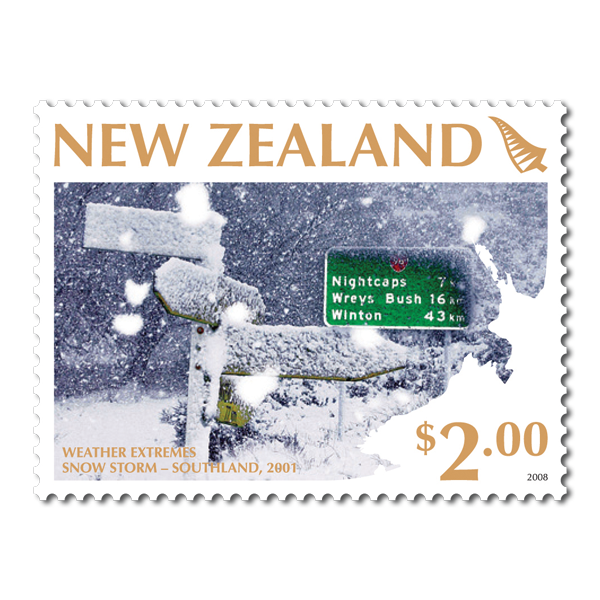 |
Single Stamp |
Single $2.00 'Snow Storm' gummed stamp. Snowflakes begin to develop when molecules of water attach to microscopic particles of clay or bacteria suspended in the air. At temperatures below minus 10ºC, more water molecules follow and tiny ice crystals form, growing to make a snowflake that falls as it grows larger. Most snow in New Zealand falls in the mountain areas, although the east and south of the South Island often experience snow in winter. |
$2.00 |
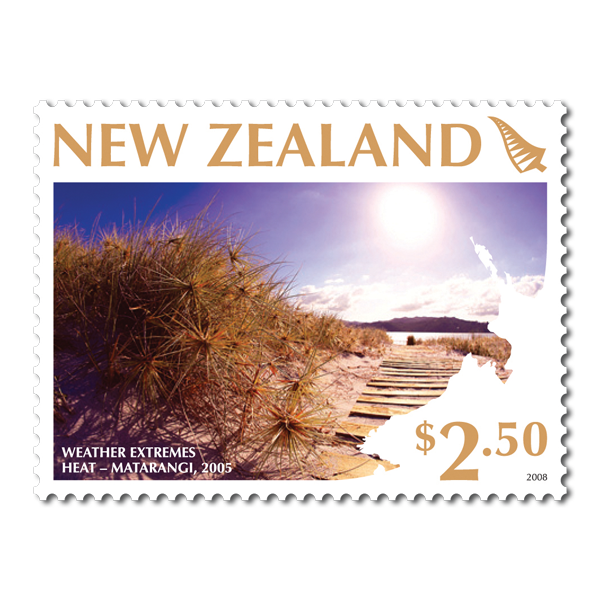 |
Single Stamp |
Single $2.50 'Heat' gummed stamp. The South Island’s eastern areas have the hottest weather in New Zealand, with summer temperatures occasionally reaching 40ºC or hotter. This scorching heat can be attributed to the intense summer sunlight heating the land (which in turn heats the air) and the westerly winds blowing down from the mountains lying to the west. |
$2.50 |
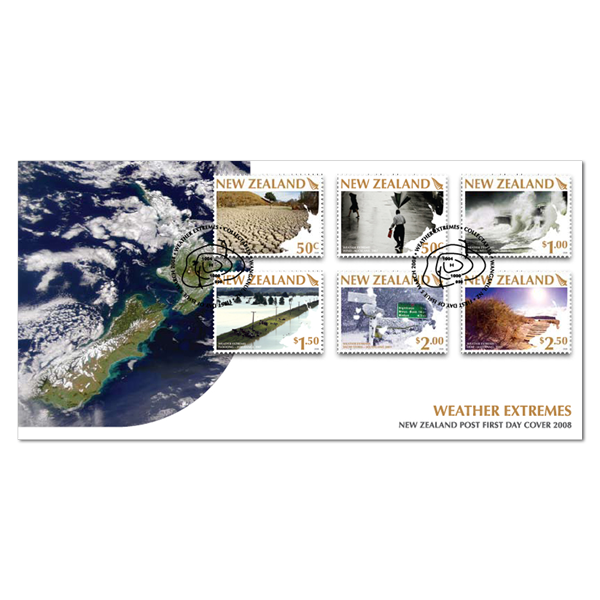 |
First Day Cover | First day cover with stamps affixed. Cancelled on the first day of issue. | $8.50 |
 |
Limited Edition | Limited edition collectable containing exclusive stamp products not available anywhere else. | $135.00 |
Technical information
| Date of issue: | 5 March 2008 |
|---|---|
| Number of stamps: | Six gummed stamps |
| Denominations and designs: | 50c (x2), $1.00, $1.50, $2.00, $2.50 |
| Stamps, first day cover and miniature sheet designed by: | Vertigo Design, Wellington |
| Printer and process: | Southern Colour Print Ltd - by offset lithography |
| Number of colours: | Four process colours plus one special colour (PMS 876) |
| Stamp size and format: | 40mm x 30mm (horizontall) |
| Paper type: | Tullis Russell 104gsm red phosphor gummed stamp paper |
| Number of stamps per sheet: | 25 |
| Perforation gauge: | 14 x 14 |
| Special blocks: | Plate/imprint blocks could be obtained by purchasing at least six stamps from a sheet. Barcode blocks were available in both A and B formats. |
| Period of sale: | These stamps remained on sale until 4 March 2009. |


